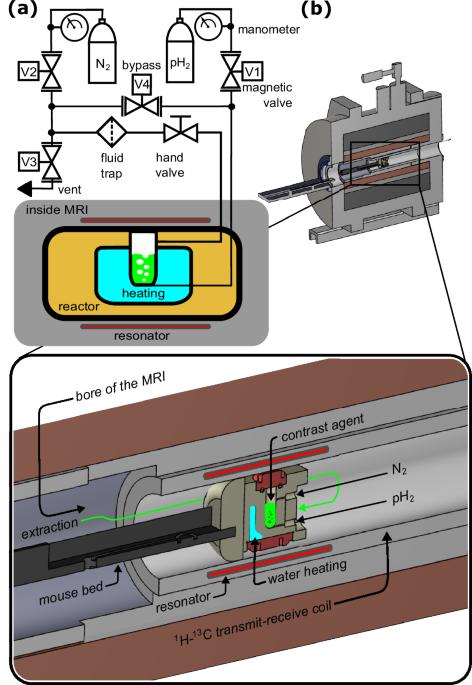Rapid in situ carbon-13 hyperpolarization and imaging of acetate and pyruvate esters without external polarizer
IF 5.9
2区 化学
Q1 CHEMISTRY, MULTIDISCIPLINARY
引用次数: 0
Abstract
Hyperpolarized 13C MRI visualizes real-time metabolic processes in vivo. In this study, we achieved high 13C polarization in situ in the bore of an MRI system for precursor molecules of most widely employed hyperpolarized agents: [1-13C]acetate and [1-13C]pyruvate ethyl esters in their perdeuterated forms, enhancing hyperpolarization lifetimes, hyperpolarized to P13C ≈ 28% at 80 mM concentration and P13C ≈ 19% at 10 mM concentration, respectively. Using vinyl esters as unsaturated Parahydrogen-Induced Polarization via Side-Arm Hydrogenation (PHIP-SAH) precursors and our novel polarization setup, we achieved these hyperpolarization levels by fast side-arm hydrogenation in acetone-d6 at elevated temperatures (up to 90°C) and hydrogenation pressures (up to 32 bar). We optimized the hyperpolarization process, reducing it to under 10 s, and employed advanced pulse sequences to enhance the polarization transfer efficiency. The hyperpolarization system has a small footprint, allowing it to be positioned in the same magnet, where 13C MRI is performed. We exemplified the utility of the design with sub-second in situ 13C MRI of ethyl [1-13C]pyruvate-d6. However, challenges remain in side-arm cleavage and purification in the MRI system to extract highly polarized aqueous agent solutions. Our results showcase efficient and rapid 13C hyperpolarization of these metabolite precursors in an MRI system with minimal additional hardware, promising to enhance future throughput and access to hyperpolarized 13C MRI. Hyperpolarized 13C MRI visualizes real-time metabolic processes in vivo, however, external polarizers are commonly required to produce hyperpolarized metabolites. Here, using a parahydrogen-based approach, the authors achieved up to 30% 13C polarization in situ in an MRI system for precursor molecules [1-13C]acetate and [1-13C]pyruvate ethyl esters in their perdeuterated forms, potentially facilitating future metabolic imaging applications.

无需外部偏振器即可对醋酸酯和丙酮酸酯进行快速原位碳-13 超极化和成像。
超极化 13C 核磁共振成像(MRI)可将体内的实时代谢过程可视化。在这项研究中,我们在核磁共振成像系统的孔内实现了最广泛使用的超极化剂前体分子的高 13C 极化:[1-13C]乙酸乙酯和[1-13C]丙酮酸乙酯的氚化形式可提高超极化寿命,在 80 mM 浓度下超极化的 P13C ≈ 28%,在 10 mM 浓度下超极化的 P13C ≈ 19%。我们使用乙烯基酯作为不饱和副氢通过侧臂氢化诱导极化(PHIP-SAH)前体,并采用新型极化装置,在丙酮-d6 中以较高温度(高达 90°C)和氢化压力(高达 32 巴)进行快速侧臂氢化,实现了上述超极化水平。我们优化了超极化过程,将其缩短到 10 秒以内,并采用先进的脉冲序列来提高极化转移效率。超极化系统占地面积小,可以放置在进行 13C 核磁共振成像的同一磁体中。我们用 [1-13C]pyruvate-d6 乙酯的亚秒级原位 13C MRI 验证了这一设计的实用性。然而,在磁共振成像系统中提取高度极化的水剂溶液时,侧臂裂解和纯化仍面临挑战。我们的研究结果展示了在核磁共振成像系统中对这些代谢物前体进行高效、快速的 13C 超极化,只需极少的额外硬件,有望提高未来超极化 13C 核磁共振成像的吞吐量和使用率。
本文章由计算机程序翻译,如有差异,请以英文原文为准。
求助全文
约1分钟内获得全文
求助全文
来源期刊

Communications Chemistry
Chemistry-General Chemistry
CiteScore
7.70
自引率
1.70%
发文量
146
审稿时长
13 weeks
期刊介绍:
Communications Chemistry is an open access journal from Nature Research publishing high-quality research, reviews and commentary in all areas of the chemical sciences. Research papers published by the journal represent significant advances bringing new chemical insight to a specialized area of research. We also aim to provide a community forum for issues of importance to all chemists, regardless of sub-discipline.
 求助内容:
求助内容: 应助结果提醒方式:
应助结果提醒方式:


